02.05.2015: I had planned to go flying today, but I think the picture below says it all….
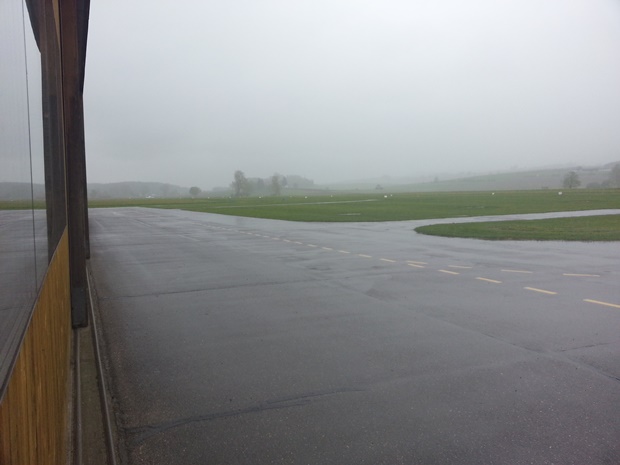
07.05.2015: Today I took another attempt to go flying, which was more successful, There were quite some clouds, but that actually made an impressive scenery.
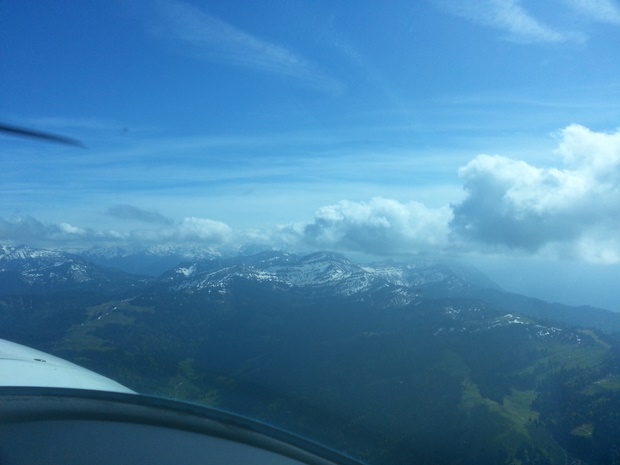
Even though it looks as if I was flying “on top”, the cloud coverage was maximum scattered, meaning there was always sufficient ground visibility.
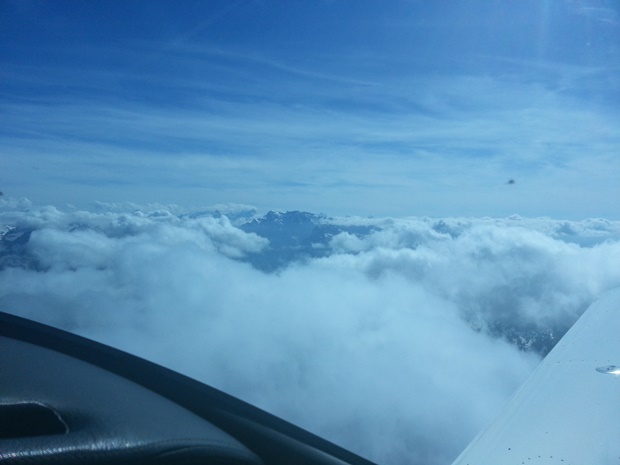
Below one can see that better, the closer i got to the alps the fewer clouds there were.
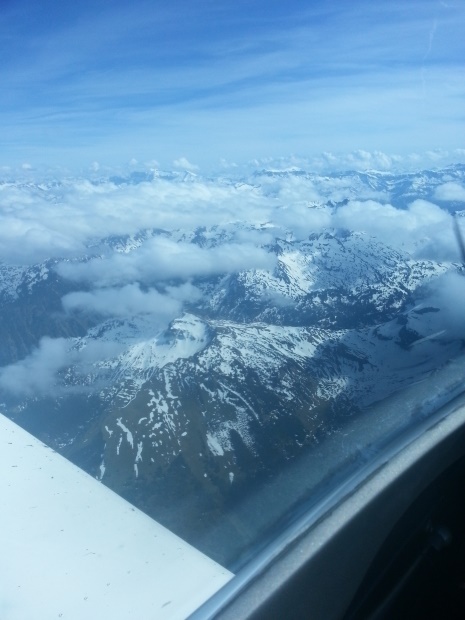
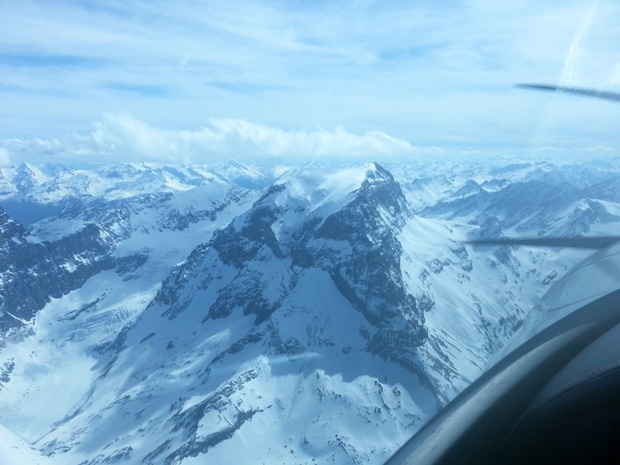
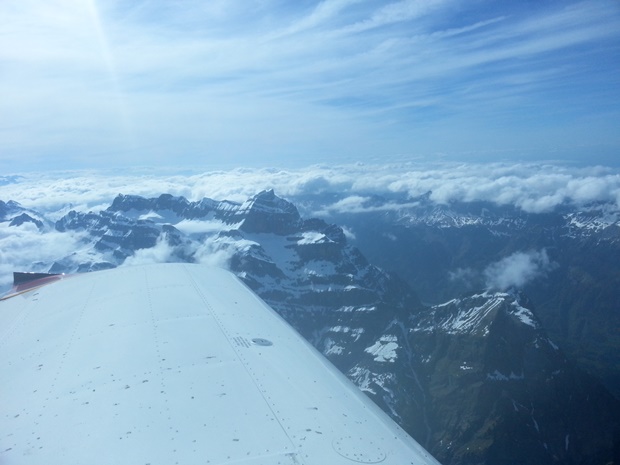
10.05.2015: My wife is on vacation for three weeks, so I decided to do a “little” trip too. I had initially planned to attend the Norwegian Experimental Aviation Association fly in, but the weather did not look too promising over the five day period I had reserved, and extending the trip was not possible due to some other obligations. Sunday and Monday looked however quite good, so I decide to fly to Wangerooge, one of the island in northern Germany.
As can be seen below the weather was nice before departure. I selected Aschaffenburg (EDFC) for customs, which I have done many times, as it lies 1:30 from Lommis and requires 2 hours prior notice for customs. That means I can decide when I want to start, give them a call, get read and timing just fits.
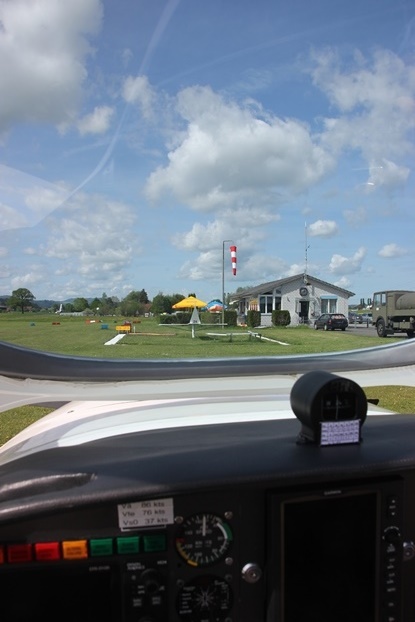
Below the Rhine river, which marks the border to Germany. Airspace over quite a stretch of southern Germany is however controlled by Skyguide, the Swiss ATC provider, due to the close proximity of Zurich airport to the border. Switching to Langen Information is therefore only done around 20 minutes / 30 miles north of the border.
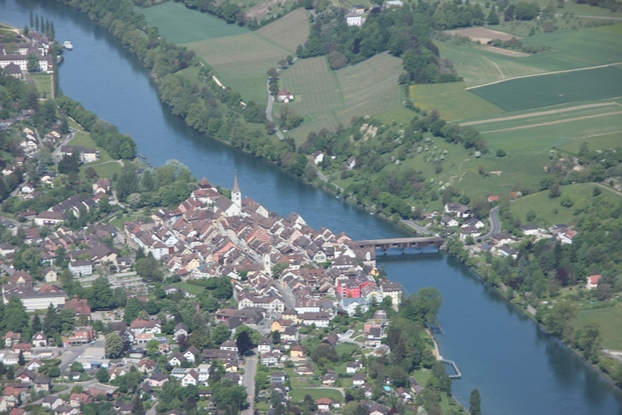
Always impressive are the dormant volcanoes in southern Germany, i wonder whether they will ever awake again.
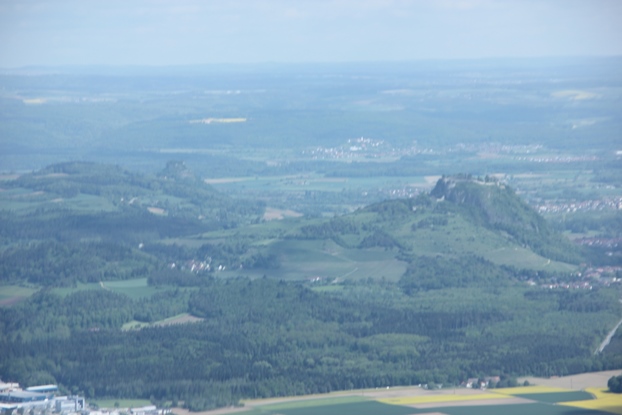
I do my flight planning for longer flights with PocketFMS on my PC at home, and then upload the flightplan into my Garmin 695 GPS , flying longer stretches mostly on autopilot. But I still plan routes that follow visible objects, such as highways, canals etc., so that I have a backup in case my fancy hardware ever fails (which so far never happend). For that reason I also still carry paper maps, even though I have considered using an iPad instead. PocketFMS would give me that option, as it can be used in flight with an iPad too, but so far I have kept the paper maps.
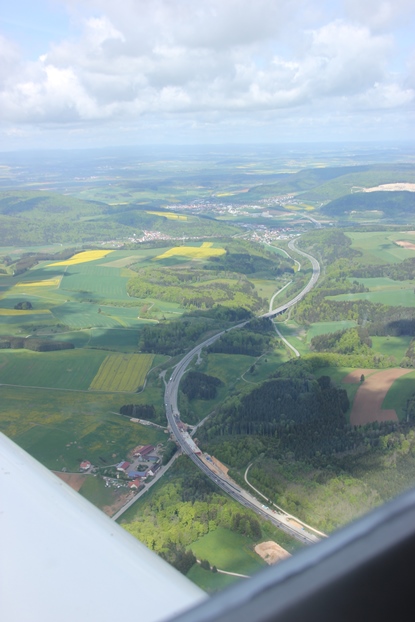
Below two shots of Heidelberg, which we visited last year (by car, not plane). A really nice city…
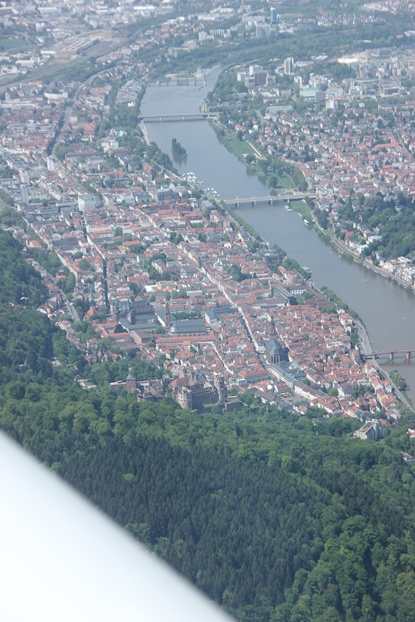
…with an impressive castle high up on a hill overseeing the old part of the city.
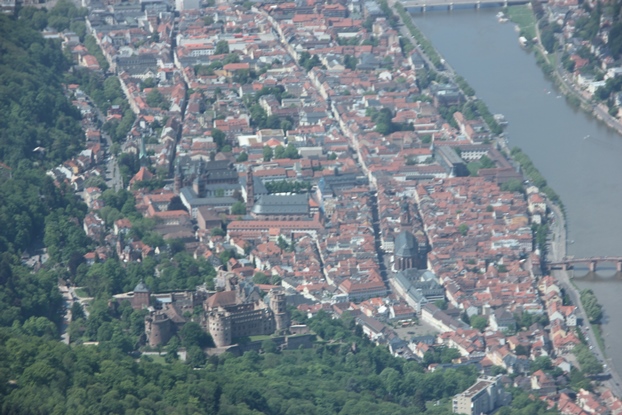
Below Frankfurt from some distance, I was navigating around the CTR and below the TMA of Frankfurt airport.

Somewhere I saw a nice little airfield cut into the forest, that would make a nice private airfield. I later found out it’s called Butzbach-Pfingstweide, and closed to external traffic. It does not even have an ICAO code.

A little later I also saw a strange little lake, in what looked like a hole in the ground. Maybe an old quarry.

I then continued past the Möhne lake, with the famous dam at the north-western end. Such lakes are good visual references in northern Germany, which otherwise looks nearly the same everywhere.

Below a good indication of what I meant with “looks the same nearly everywhere”….

Canals are good too, they are much better than for example railway lines, as they “break” the scenery with their long, straight stretches as shown below. Railway lines normally blend in with the surroundings, and often disappear either in tunnels or in forests.
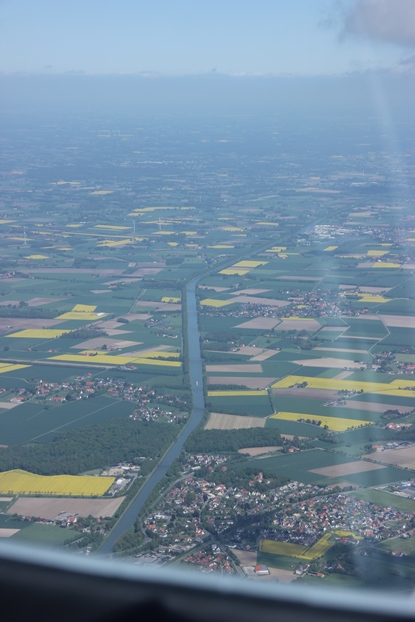
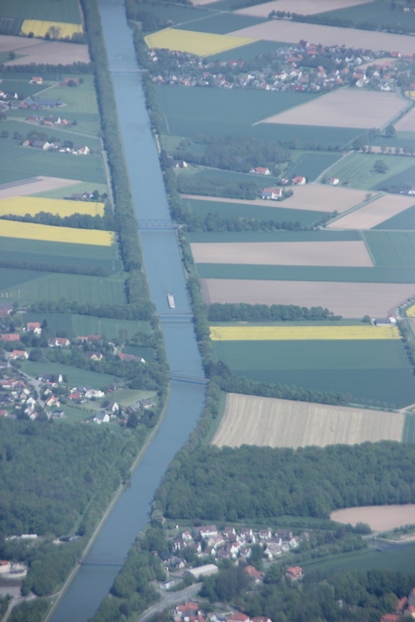
I also saw an airport which looked as if the runway was across a lake, but when I got a little closer I noticed that the runway was just surrounded by a gigantic arrays of solar panels. The airport is called Ahlhorn, again with no ICAO code, and was formerly a Luftwaffe airbase. It is now owned by a developer, who is turning it into an industrial park, but wants to retain the airfield operational.

As a next stop after Aschaffenburg I selected Wiefelstede-Conneforde (EDWP) airfield, due to the availability of Mogas. The airfield lies around 30 km southwest of Bremerhaven, so pretty close to the coast, and has a 600 m grass runway which is more than sufficient for the SportCruiser. It also lies around 10 km north of a lake which isaround 2 km in diameter, so it’s fairly easy to find.

After landing I had to admit that Wiefelstede-Conneforde was an excellent choice, with very friendly people and even a choice between 95 and 98 octane unleaded fuel, plus Avgas in case you need it. The only limitation is that you have to pay cash, luckily I had enough with me. I filled the tanks, which took 60 l of Mogas, not much for already having flown 4:18.
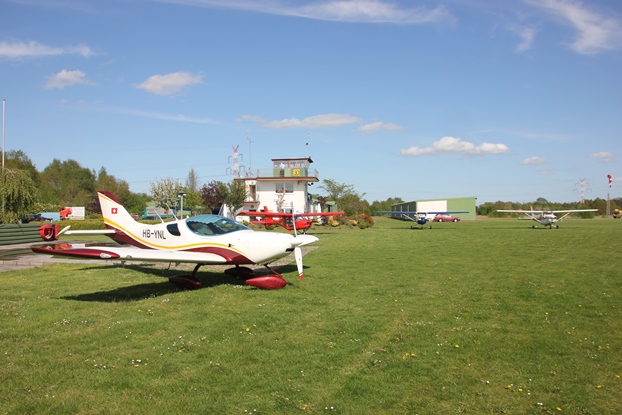
Below some pictures of the airfield, what you can’t see are the friendly people. The guy on the tower even asked one of the members to help me refuel, with the result that I could have sold him my SportCruiser…



The airfield is in a picturesque setting next to a small lake, and there is a campsite right next door. The guy on the tower also pointed out that there is a possibility to rent rooms or cabins at the campsite, with very moderate prices, so this could even be a place for a night stop when flying north.
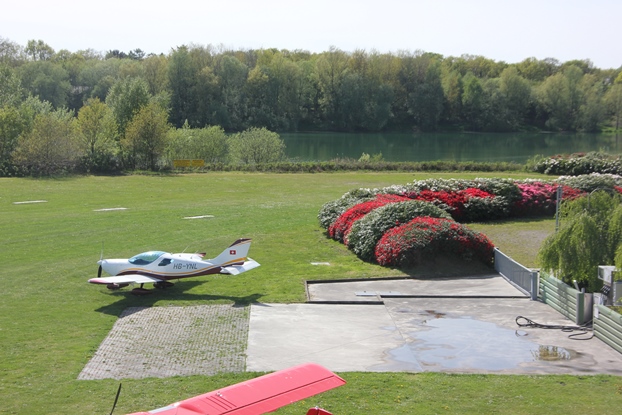

Below a view back just after departure. You should turn left after straight after takeoff from Runway 30 to avoid overflying the campsite.

I then continued towards Wangerooge (EDWG), my final destination for the day. I could have flown there in 20 minutes, but decided to do a little detour to pass the port of Bremerhaven.

Below it can be seen, unfortunately my pictures of the container ships lying in port are all not sharp.
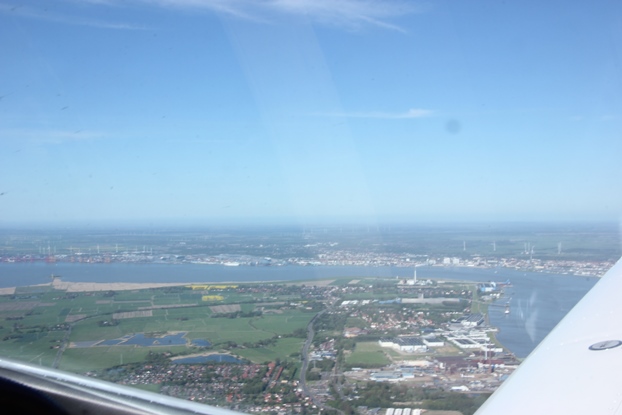
I then headed toward the islands passing some smaller ones…

…before reaching Wangerooge which is the eastern most of the German part of the long string of islands. The western most island belonging to Germany is Borkum, where we wentlast year, the islands west of it belong to the Netherlands.
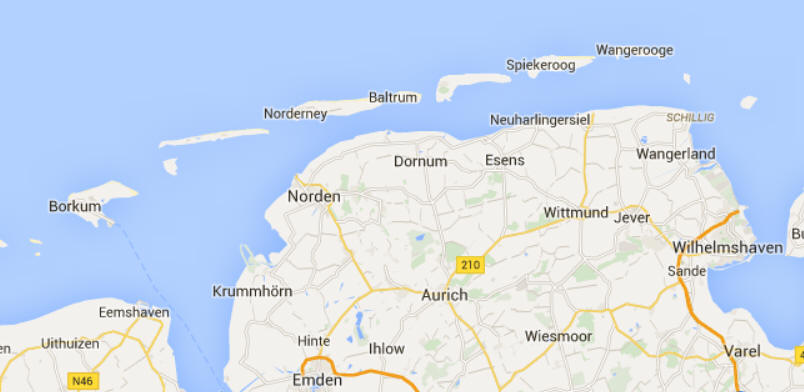
I selected Wangerooge first of all because I have not yet been there but also because you can walk from the airfield to the town in a few minutes. Wangerooge airfield can be crowded in summer to the point where you might not receive landing permission because the 100 (!) parking spots are all occupied, but that was no issue today.
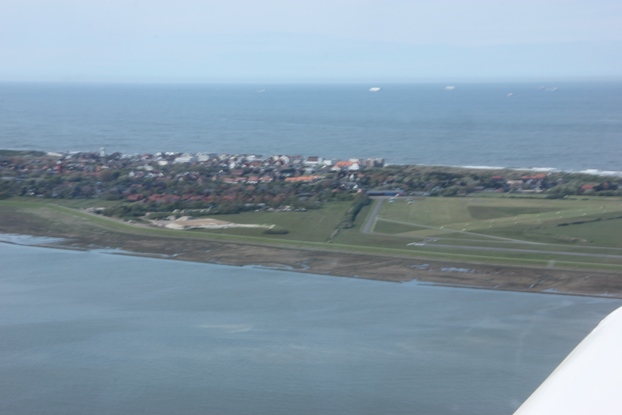
Before landing I passed the 56 m tall tower at the western end of the island, which is now a youth hostel. It is an impressive structure, and is not to be taken as a lighthouse.

Just after landing some Britten-Norman Islander planes arrived and departed, the same ones you can also see on the other islands and on Helgoland. There is an impressive frequency of scheduled flights to and from Wangerooge.
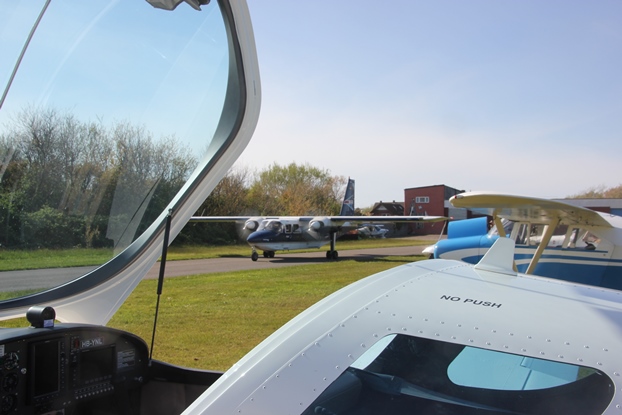
I then parked my plane, tied it down (unlike all the other planes) and left for the hotel.
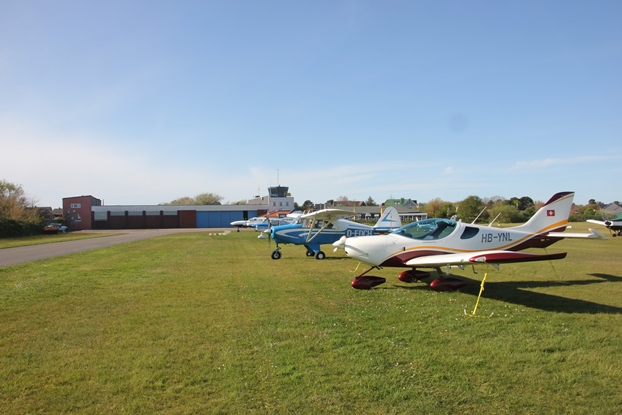
I did a little tour through “downtown” Wangerooge, with it’s typical northern “charm”…

…ending up eating on an outside terrace my local favorite, Matjes Houswife Style with a Jever Pils.

Below some more impressions from Wangerooge.




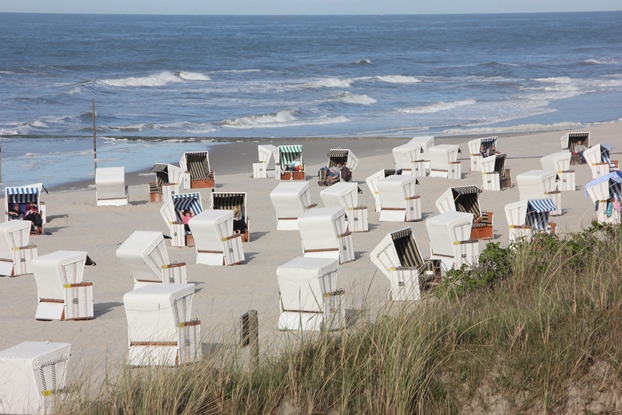
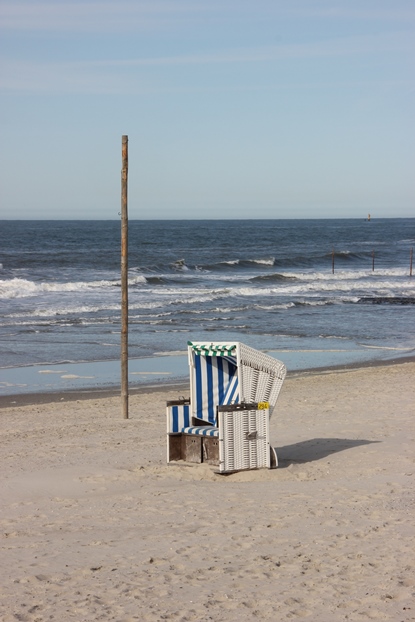

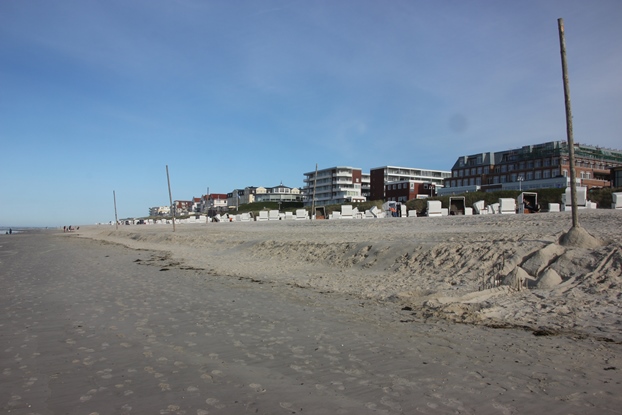
11.05.2015: I had to do this trip as a two day trip only, so it was already time to head back to Switzerland. I went to the airfield after a healthy breakfast, to notice that only two planes had actually stayed overnight. That explains why nobody else used tie downs.
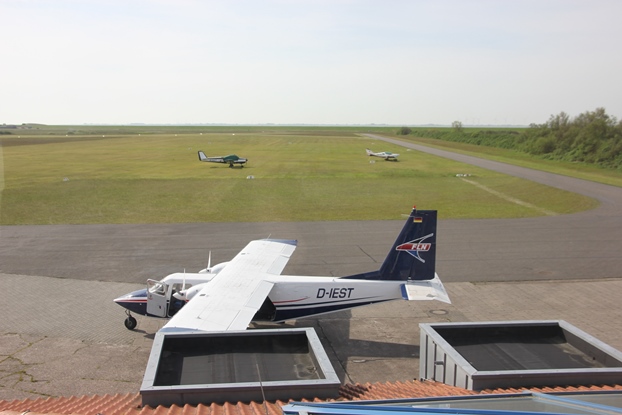
Below a view back after takeoff, definitely a place to come back to. I decided to still land at Langeoog (EDWL), which lies only 25 km west of Wangerooge. There is one island in between the two, called Spiekeroog, but that one does not have an airfield.
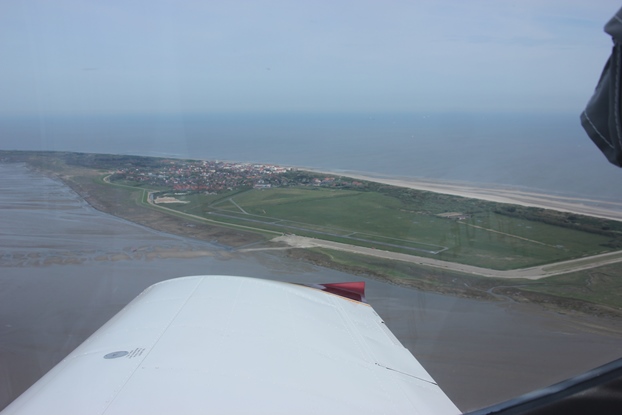
The tides were low, so I could again see the structure of the Watt.



Langeoog is pretty similar to Wangerooge, except that everything but the airfield seems a little smaller. I had planned to stay only fifteen minutes, but finally stayed nearly half an hour on the tower talking to the guy from ATC. He told me he is flying in Hamburg, and also working there on the tower, so he gave my some tips how I can get permission to cross the city at low level through the CTR of Hamburg Airport, in return I answered his many questions on homebuilding.
With my flight to Langeoog I reached my 500th flying hour in powered aircraft since I started flying again in 2002. That’s an average of 38 hours per year, which is quite a lot for a private pilot that is not doing any kind of “commercial” activity such as passenger sightseeing flights, glider towing etc.

I then departed again, passing the ferry terminal with a train station. Some of the island have little trains from the ferry terminal to the town, shuttling day tourist back and forth.


When heading east again I saw quite many ships on anchor, obviously empty and probably waiting for cargo.

I passed Wangerooge again…
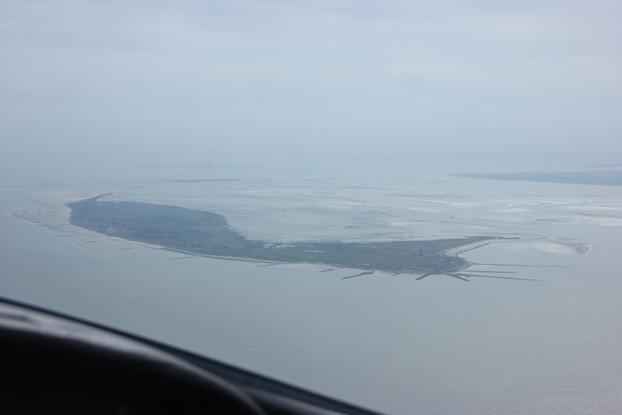
…with a view of the beaches where I had been only two hours earlier.

I the flew across the sea toward the mouth of the Elbe river, passing some navigation aids for the ships, such as this lighthouse.

This included the island of Neuwerk, with a modern radar tower on the left and an old lighthouse in the centre.
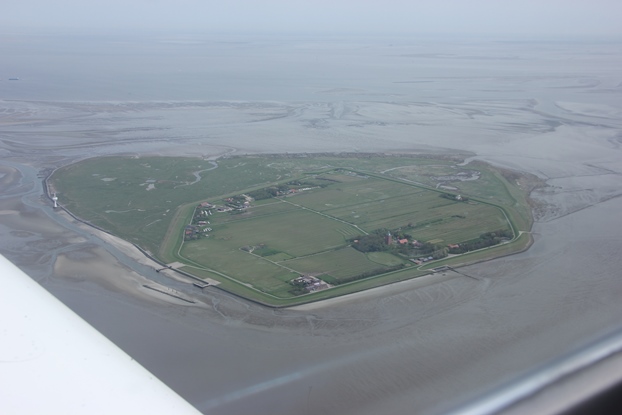
Next I passed Cuxhaven, a large deep-water port which is also home for quite significant fishing activities. It is also the departure point for the ferries to Helgoland.


The Elbe river is impressive, many kilometres wide at its mouth and pretty shallow at low tide except for a twisting deep water canal toward Hamburg harbour.
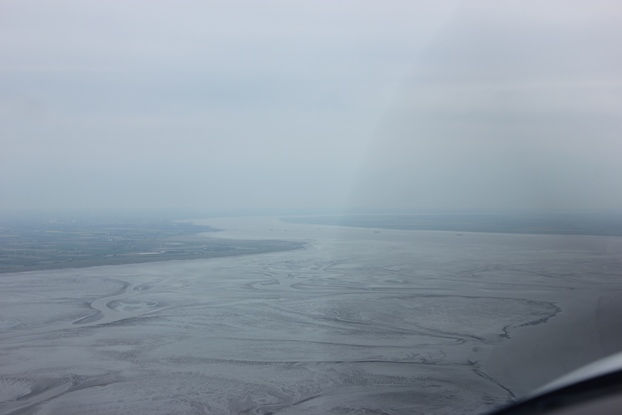


I passed the western end of the Nordsee-Ostsee canal, with two bigger ships visible,…

one of them a cruise ship just passing one of the locks.
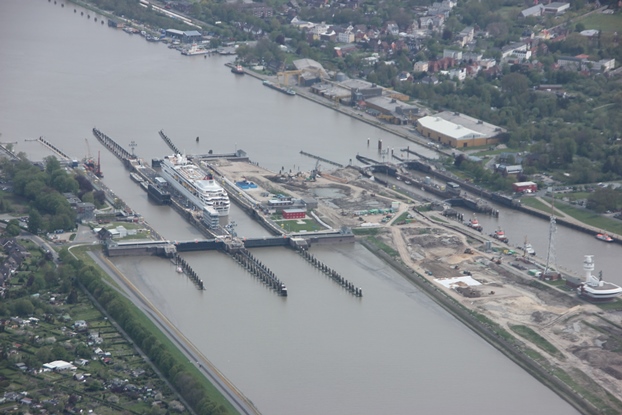
Along the Elbe there are some bigger nuclear installations, all easy to spot on the GPS because of the small restricted areas, such as in Brunsbüttel (out of operation)…

…and Brockdorf, which is still operating. A strange combination of a sailing ship in front of a nuclear power station,…

…here a closer picture of the ship.

I then passed Glückstadt, with an impressive group of old brick buildings…

…before passing four big towers carrying power lines cross the river. The towers are nearly 800 ft tall, and well marked on both the map and on my GPS as obstacles. This is where the guy from the tower in Langeoog told me I should contact Hamburg tower to ask to cross the CTR via W1, S2 and S1, a request which was immediately granted.

I then flew at an altitude of 1000 ft along the Elbe towards the centre of Hamburg,…

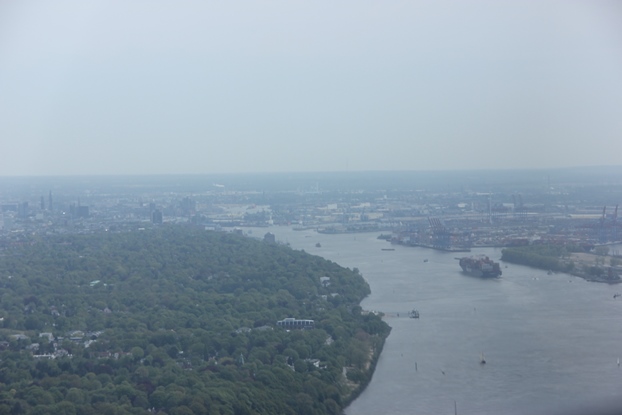
…passing Finkenwerder with the large plant of Airbus, which is indeed very large.


Compare the size of the Airbus A380 with the buildings around it.

I then continued via the container port…
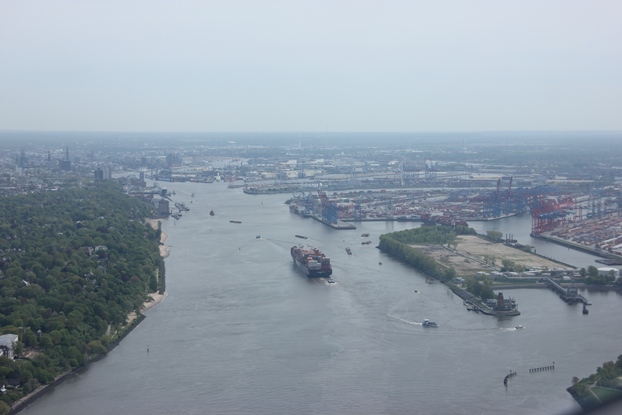

…with a nice view on downtown Hamburg.
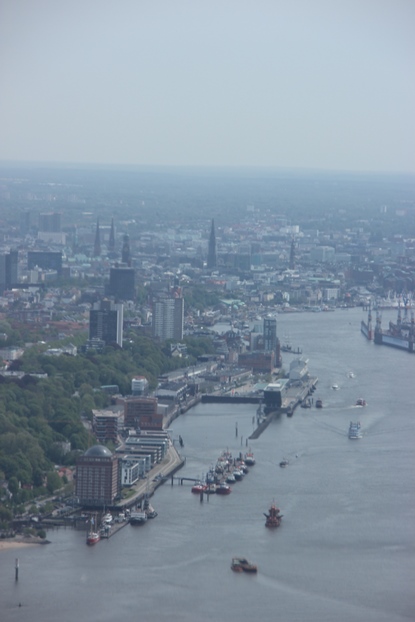
On container ships was just arriving,…
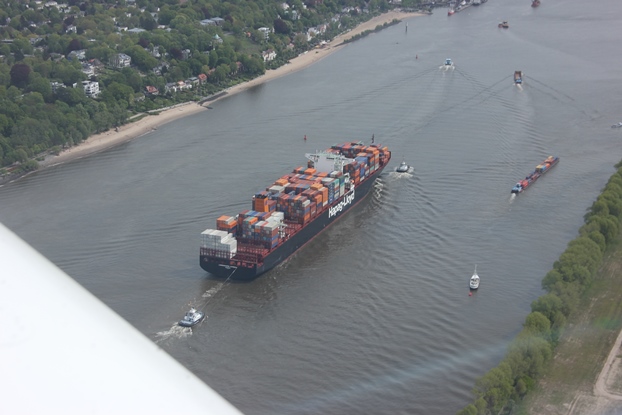
… while another one was being turned around in the harbour, probably to depart.
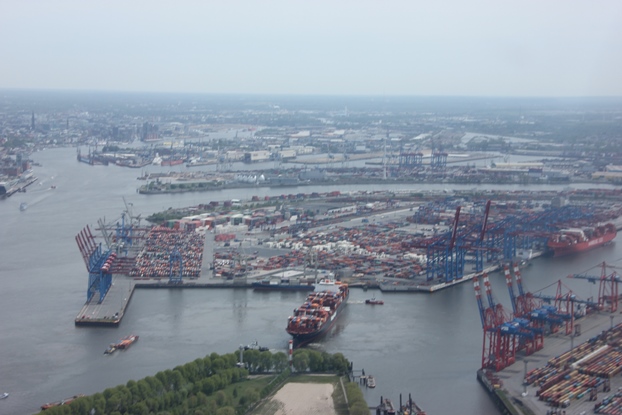
We have been in Hamburg a few years ago, and it’s nice to also see all of it from above.
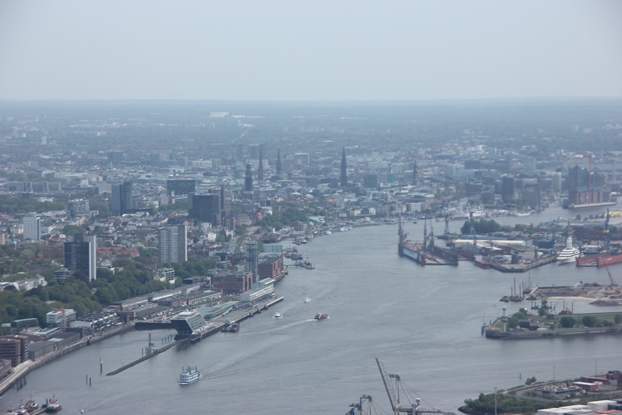
S2 reporting point is a tall bridge, easy to find, from where one then heads south again.
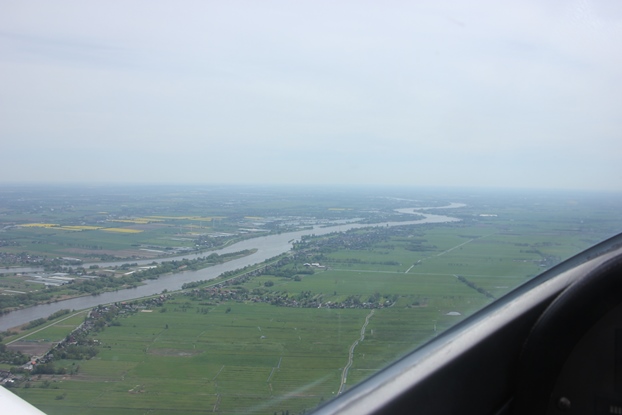
From Hamburg I flew past Lueneburg (EDHG), where we landed last year on our way to Denmark, also a very nice place.
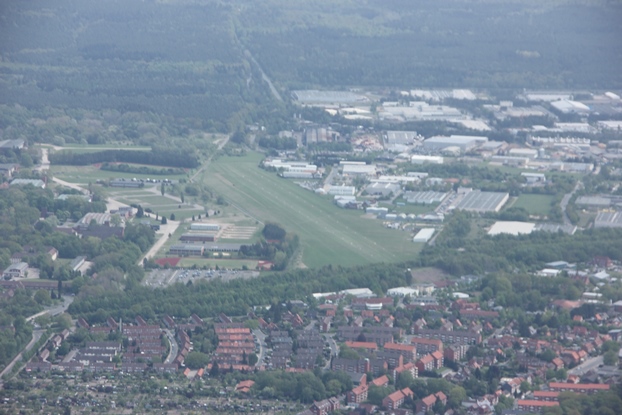
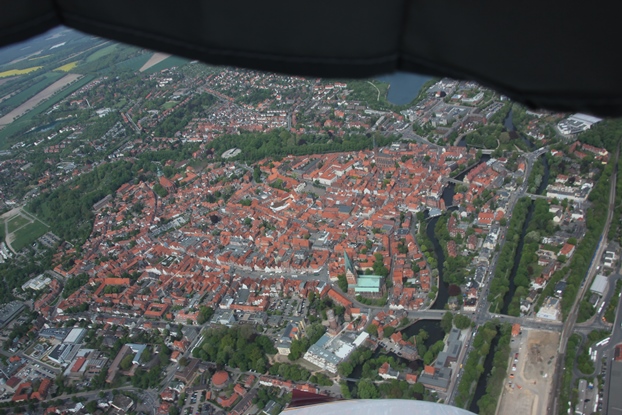
I then headed south, along the Elbe-Seitenkanal towards Braunschweig and Hildesheim (EDVM), my fuel stop.

Below the locks near Uelzen, with 23 m lifting height quite impressive. On the right side are water basins, in which the water is collected when emptying the chambers, for reuse when they need to be filled again.
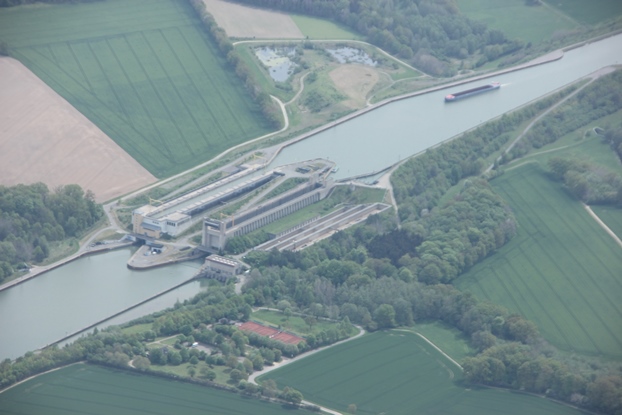
Below the first view of Hildesheim airport, which I again selected for a stop due to the availability of Mogas. That again proved to be a good choice, with a very convenient fuel station with Mogas, Avgas and JET-A. It’s truly self service, with credit card payment.

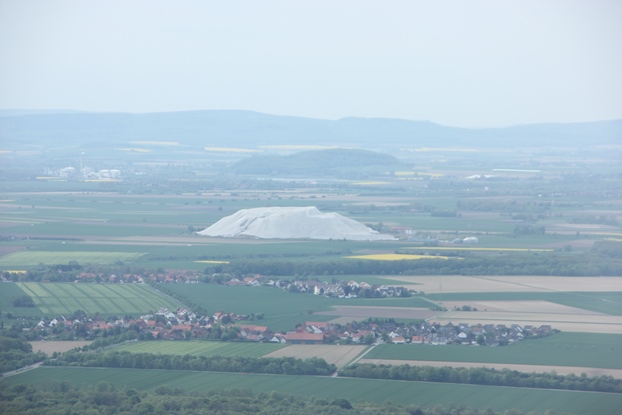
Below a view from the tower in Hildesheim. If you’re overweight then this is not the place to go, as you have to climb up to the tower to pay your fee, which is probably 15 m above the tarmac (no elevator).
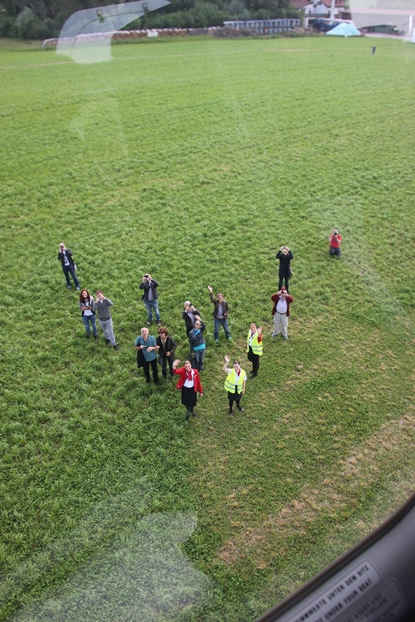
From Hildesheim I headed south for a stop for customs in Friedrichshafen (EDNY). I had announced to customs my arrival in Lommis at 19:00, but had quite some headwind (25 kts at 4500 ft), so timing started to get a little tight. I therefore descended to 3000 ft, where the headwind was only around 15 kts, and flew for three hours with around 5400 rpm, which is just 100 rpm below max cruise power. Fuel flow at that power setting is around 20.5 l/h, which is not significantly higher than the 18 l/h I fly normally.
Approaching Ulm I saw the alps appearing from the haze, always a nice sight.
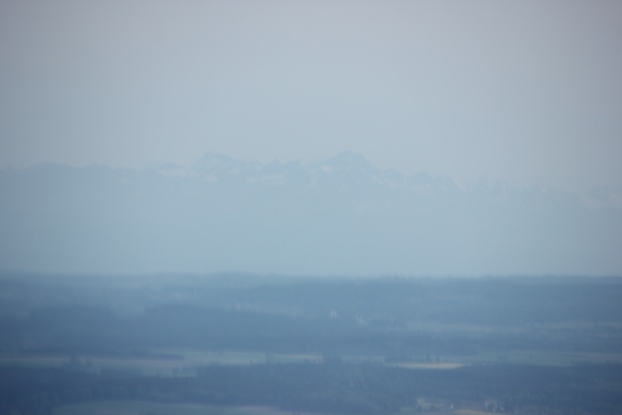
Below the Federsee near Biberach, another good spot for navigation.

Shortly thereafter I cold see Friedrichshafen airport, where I have been many times to visit Aero but never flown to myself. The approach was unspectacular, I just had to do a 360 for separation before entering the CTR.

Below on final, one can see the bugs I had collected on my windshield. Next time I will carry some detergent to clean the windshield when leaving for several days..

After issuing my flight plan for the short flight to Lommis I departed again, I got a departure via Whiskey, which is on the shore of the lake and more or less on the straight course to Lommis.
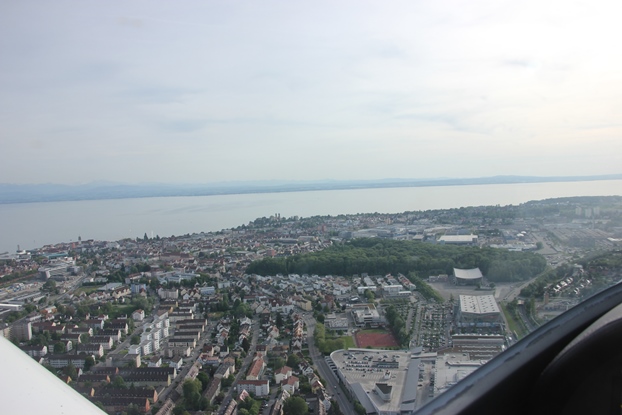

Below Konstanz, where one nearly already has to start the approach briefing for Lommis, which is only 10 miles away. If you hurry then the flight from Friedrichshafen to Lommis takes around 15 minutes, barely enough to contact ATC for the border crossing and to close the flight plan again, but I slowed down a bit to land just a few minutes before seven.
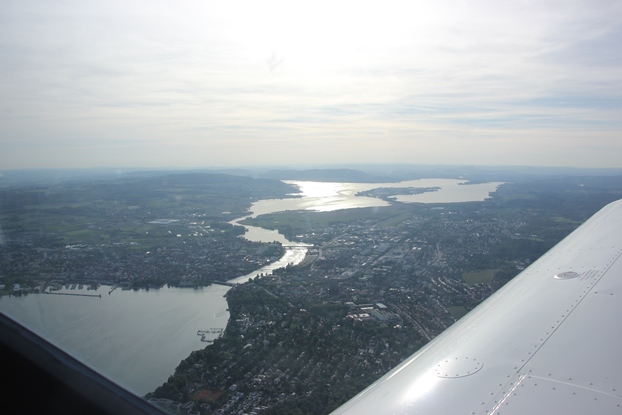
Below a picture after arrival, with no customs showing up. That was a great short trip, I think I will do more of them this year.

All in all this trip was over close to 1’000 nm, with an off-block time of 11:34, airborne time of 10:52 and a fuel consumption of around 200 l, all unleaded. If I would have made the trip by car then I would have driven around 2100 km, which would have taken around 22 hours not counting any traffic delays and ferries. Fuel consumption with a modern car which takes around 7 litres / 100 km (mostly highway at 120 km/h) would have been around 150 litres, so nearly as much as by plane.
This trip again confirmed that my decision to install an autopilot was a good one. I wouldn’t want to do such a flight without one in a light and lively aircraft such as the SportCruiser, especially when flying alone. It’s easier if you are flying with someone else, which might help with different chores, but when flying alone you have to do everything yourself like the actual flying, navigating, talking to ATC, retrieving and stowing of maps (you need at least four maps to cross Germany South – North), getting food out of the flight bag, taking pictures etc. etc.
13.05.2015: Two years ago we decided in our flying club to buy two two-seater training airplanes, in order to lower the cost for initial flight training, but also to improve the availability of our four seaters for renting. After a lengthy evaluation process we finally selected the Aquila A-211, and ordered them sometime later last year. The first Aquila arrived in Lommis on the 21st April, below a picture courtesy of MFGT.
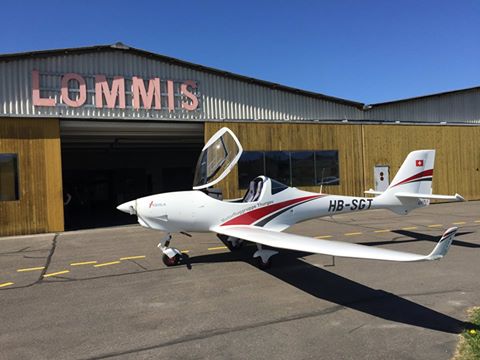
I decided that I want to be able to fly the Aquila too, as I sometimes to technical check-flights for the maintenance. My re-validation flight was due too, so we combined the two. We did two flights with a total of a bit over two hours with six landings, and it went pretty well as I am quite used to fly light aircraft, and am also accustomed to electronic instruments instead of traditional gauges. The only new thing for me is the adjustable propeller, which is indeed needed for the Aquila as it has the same Rotax engine as the SportCruiser, but weights much more with 750 kg MTOM compared to the 630 kg of my SportCruiser. It does fly quite fast thanks to it’s glider quality aerodynamics, but only at a relatively high power setting. You can reach around 107 kts indicated airspeed at 3500 ft, maybe 10 kts more than with the SportCruiser.
27.05.2015: I had forgotten that my language proficiency expires at the end of the month, so I did it quickly today.
29.05.2015: Today was a special day, as I had my first flight in a Zeppelin! (unfortunately only as a passenger)

The Swiss airline Edelweiss, which mostly operates flights to holiday destinations, has it’s 25th anniversary, so they decided to hire a Zeppelin for a few months and to offer scenic flights for a bargain. That’s probably better publicity than just running some full size adds in major newspapers, or to distribute some giveaways, and probably also not more expensive.
They published the flights recently through some ads, pointing out that you could book them through their normal booking system, with the result that the booking system broke down for a short time due to the huge number of people attempting to book flights. Fortunately I managed to book two flights once the had restarted the booking system before they were all sold out.
The now retired long time CEO of Edelweiss, who still flies for them as captain on A330s, is a fellow homebuilder. I asked him during a recent meeting whether he is doing the flights by himself, and indeed he had checked what it would cost to get the Zeppelin licence, but unfortunately it was too expensive.
Anyway, the flight I had booked for my wife and myself took place today from a field near Mönchaltorf near Zurich, where we drove to this morning. When we arrived there the first thing we saw was a Stork, always a great sight.

Getting nearer to the landing site you could not miss the Zeppelin, nicely painted in the colours of Edelweiss. It was still moored at it’s mast, obviously staying there overnight.
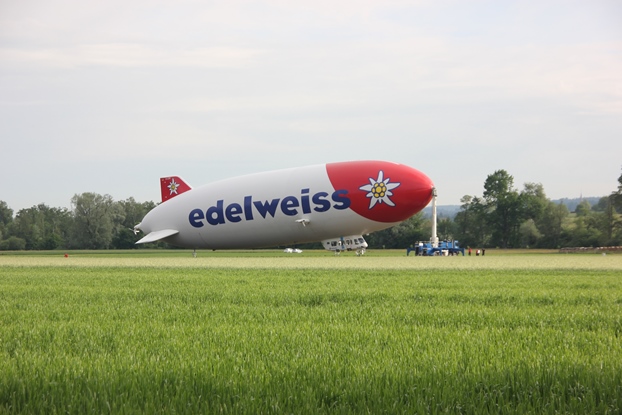
When getting closer we started to recognize how big it is. With a length of 75 m, a height of 18 m and a width of 20 m it is larger than an A380, at least in volume. the MTOM is however only around 8’000 kg, which is around 70 times lighter than an A380.
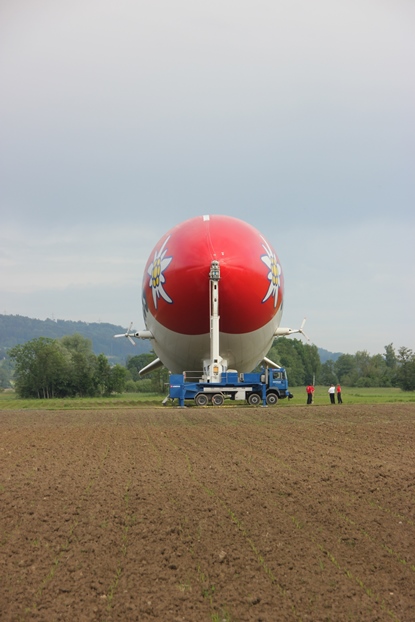
The main problem of Zeppelins is that they always need to be more or less in balance, meaning when parking it overnight they have to load it with ballast as they don’t want to vent the helium. So the first passengers had to board it, then they took the ballast out (a pile of weights) and then drained water ballast until lift and weight were equal.
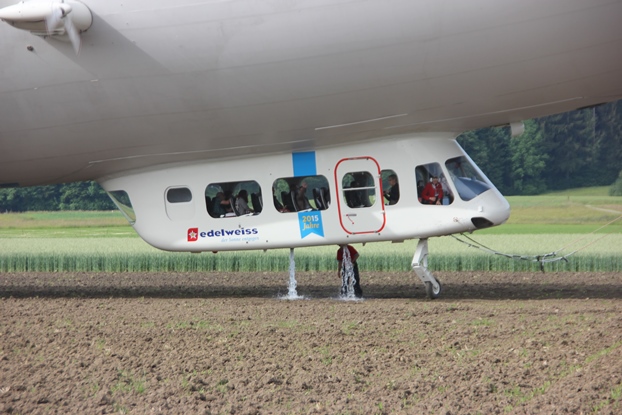
Once balanced it took off very quietly with an impressive climb rate and angle.


Our flight was the second one, so we had a safety briefing and boarding instructions soon after it had left. When finished we still hat to wait a while before it returned to pick us up.
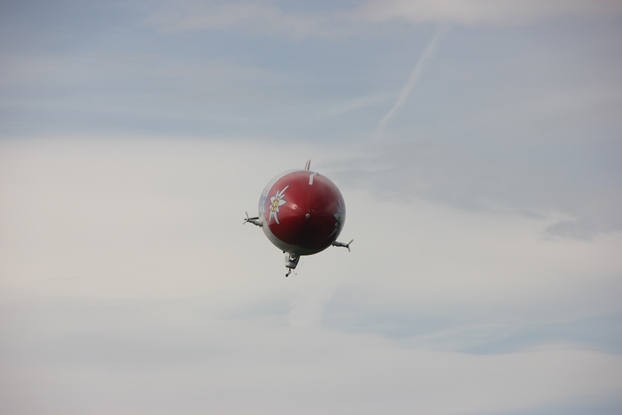

They do “flying” passenger changes, meaning the Zeppelin is not moored but only lands briefly for a quick passenger exchange.

The procedure is quite funny, first two new passenger have to get on, then two have to disembark, then the next two embark and so on until the entire load is exchanged. Like that they avoid that the weight gets too low, as it could just lift off in an uncontrolled way if all passengers would get off at once.

The takeoff was nearly as in a helicopter, but much more quiet even though the three engines were running at power.
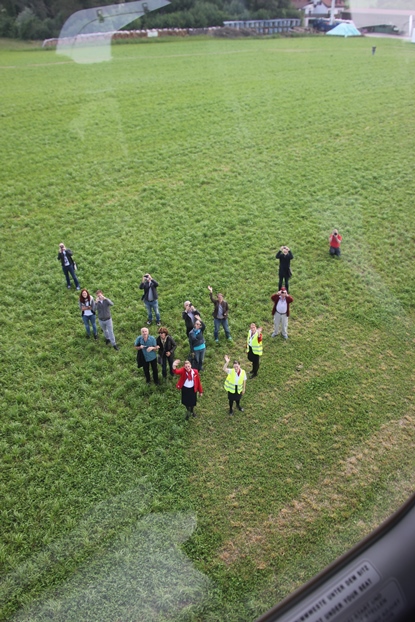
Below a series of pictures I took during the flight, which from the Mönchaltorf across the hills to Meilen, on the shore of the Lake of Zurich, then along the lake to overhead the city centre of Zurich and then back.
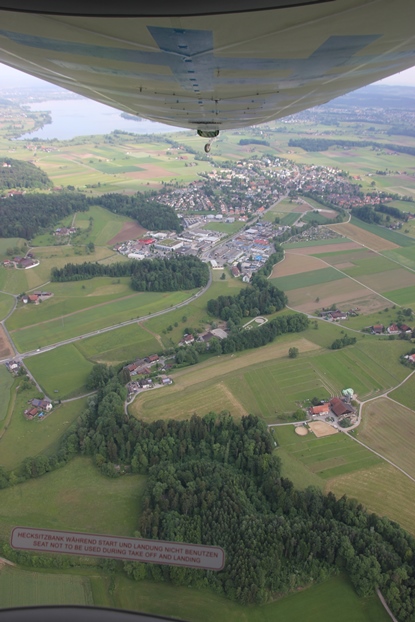
One airborne you were allowed to walk around freely.
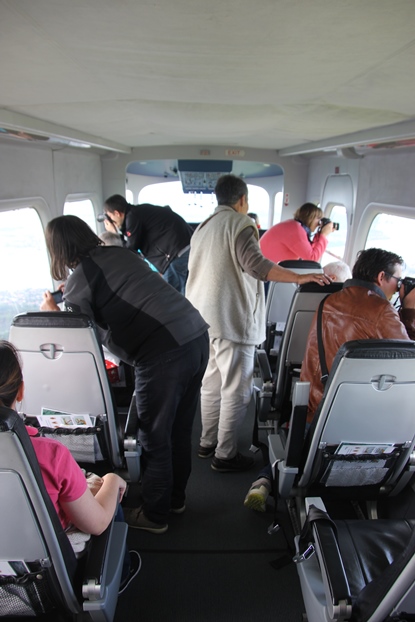
Here the cockpit (with no reinforced door), one can see the three mixture and propeller pitch levers.

Most instruments are the same as on a normal plane, except one which is helping the pilots control the balance of the Zeppelin.



We overflew the nursery in Meilen, which once belonged to my grandfather and is now run by one of my cousins.

Car ferries operate across the lake from Meilen to Horgen, allowing people to avoid having to cross the city of Zurich.







Below the standard magnetic compass as in every aircraft, it seem’s to be affected by the electric heaters…

Some more Zeppelin specific instruments.

The throttle levers are suspended from the overhead panel, just like on a De Havilland Beaver.























After departure the pilot told us that we absolutely have to have a look at the loo, from which one has a spectacular view, and he was right.

Below the mooring mast, as well as two trucks with equipment, Helium, fuel etc.




I have to admit that this was an absolutely spectacular flight, now my wife wants me to build a Zeppelin as the next project….